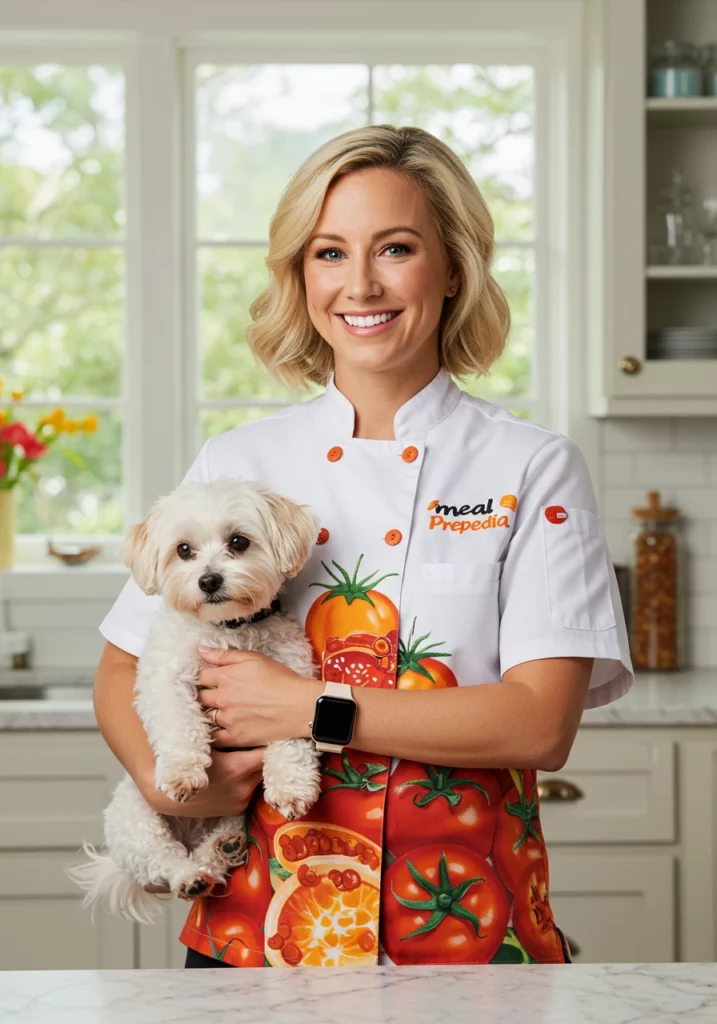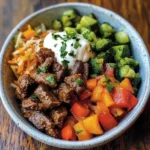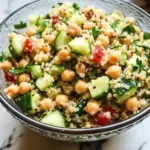Okay, let’s dive into the delicious world of Thai Peanut Chicken Lettuce Wraps! This recipe has become an absolute staple in my household. The first time I made them, my family went wild! The kids, who can sometimes be picky, devoured them, asking for seconds and even thirds. What I personally love is the incredible explosion of fresh, vibrant flavors – the savory chicken, the creamy, nutty peanut sauce, the crisp, cool lettuce, and the crunch of fresh veggies and peanuts. It’s a meal that feels both indulgent and surprisingly healthy, perfect for a weeknight dinner when you want something exciting but also relatively quick to whip up. The interactive nature of building your own wrap at the table also makes it a fun and engaging meal for everyone. Honestly, the aroma alone, as the peanut sauce simmers and the chicken sautés with those fragrant Asian spices, is enough to make your mouth water. It’s a dish that truly satisfies on every level – taste, texture, and even visual appeal.
Ingredients for Irresistible Thai Peanut Chicken Lettuce Wraps
Here’s what you’ll need to gather to create this flavor-packed dish. Each component plays a crucial role in building the layers of taste and texture that make these lettuce wraps so special.
For the Luscious Peanut Sauce:
- ½ cup creamy peanut butter: The star of the sauce, providing a rich, nutty base. Choose a good quality natural peanut butter if possible.
- ¼ cup low-sodium soy sauce (or tamari for gluten-free): Adds a deep, savory, umami flavor.
- 2 tablespoons rice vinegar: Provides a tangy acidity that balances the richness of the peanut butter.
- 2 tablespoons honey (or maple syrup for vegan sauce option, though we use chicken here): Lends a touch of sweetness to round out the flavors.
- 1 tablespoon lime juice: Freshly squeezed is best for a bright, zesty kick.
- 1 tablespoon sesame oil: Toasted sesame oil offers a distinctive nutty aroma and flavor.
- 1-2 cloves garlic, minced: Fresh garlic for that pungent, aromatic base.
- 1 teaspoon fresh ginger, grated or minced: Adds a warm, spicy note.
- ½ – 1 teaspoon Sriracha or red pepper flakes (optional): Adjust to your preferred level of heat.
- 2-4 tablespoons hot water: To thin the sauce to your desired consistency.
For the Flavorful Chicken Filling:
- 1.5 lbs boneless, skinless chicken breasts or thighs, cut into small ½-inch pieces: Chicken thighs will be more tender and flavorful, but breasts work wonderfully too.
- 1 tablespoon olive oil or avocado oil: For sautéing the chicken and vegetables.
- 1 medium red onion, finely chopped: Adds a sweet and slightly pungent flavor.
- 2-3 cloves garlic, minced: More garlic for layering flavor into the chicken.
- 1 red bell pepper, deseeded and finely chopped: For sweetness, color, and a slight crunch.
- 1 orange or yellow bell pepper, deseeded and finely chopped: Adds more color variety and sweet notes.
- 1 cup shredded carrots (about 2 medium carrots): For sweetness, color, and texture.
- ½ cup water chestnuts, drained and chopped (optional): For a fantastic, signature crunch.
- ¼ cup chopped fresh cilantro, plus more for garnish: Adds a bright, herbaceous note.
- 2-3 green onions, thinly sliced, plus more for garnish: For a mild oniony bite and freshness.
- Salt and freshly ground black pepper to taste: Essential for seasoning the chicken.
For Serving (The Wraps & Toppings):
- 1-2 heads of butter lettuce, Bibb lettuce, or Romaine hearts: Choose leaves that are sturdy enough to hold the filling but still tender. Wash and pat them dry carefully.
- ¼ cup chopped roasted peanuts: For an extra nutty crunch and flavor.
- Sesame seeds (optional, for garnish): A sprinkle adds a nice visual touch and subtle nutty flavor.
- Extra lime wedges: For a final squeeze of brightness.
Crafting Your Culinary Masterpiece: Step-by-Step Instructions
Follow these steps carefully to create Thai Peanut Chicken Lettuce Wraps that will tantalize your taste buds and impress your guests. The process is straightforward, focusing on building layers of flavor.
- Prepare the Peanut Sauce: In a medium bowl, whisk together the creamy peanut butter, soy sauce (or tamari), rice vinegar, honey, lime juice, sesame oil, minced garlic, grated ginger, and Sriracha (if using). The mixture will be quite thick. Gradually whisk in the hot water, one tablespoon at a time, until the sauce reaches a smooth, pourable consistency, similar to heavy cream. You want it thick enough to coat the chicken but not so thick it’s clumpy. Taste and adjust seasonings if necessary – more soy for saltiness, lime for tang, honey for sweetness, or Sriracha for heat. Set aside.
- Cook the Chicken: Pat the chicken pieces dry with a paper towel and season generously with salt and pepper. Heat the olive oil (or avocado oil) in a large skillet or wok over medium-high heat. Once the oil is shimmering, add the chicken pieces in a single layer (you may need to do this in batches to avoid overcrowding the pan, which can cause the chicken to steam rather than brown). Cook for 5-7 minutes, stirring occasionally, until the chicken is golden brown on all sides and cooked through. Remove the cooked chicken from the skillet and set it aside on a plate.
- Sauté the Aromatics and Vegetables: To the same skillet (add a little more oil if needed), add the chopped red onion and cook over medium heat for 2-3 minutes, until softened and translucent. Add the minced garlic and cook for another minute until fragrant, being careful not to burn it.
- Add Remaining Vegetables: Add the chopped red and orange bell peppers and shredded carrots to the skillet. Sauté for 4-5 minutes, stirring frequently, until the vegetables are crisp-tender. You want them to retain some of their bite. If using water chestnuts, add them in the last minute of cooking.
- Combine Chicken, Vegetables, and Sauce: Return the cooked chicken to the skillet with the vegetables. Pour about half to two-thirds of the prepared peanut sauce over the chicken and vegetable mixture. Stir well to ensure everything is evenly coated. Let it simmer for 2-3 minutes, allowing the flavors to meld together and the sauce to thicken slightly and cling to the chicken and veggies. If the mixture seems too dry, you can add a splash more of the peanut sauce or a tablespoon of water.
- Stir in Fresh Herbs: Remove the skillet from the heat. Stir in the ¼ cup of chopped fresh cilantro and the sliced green onions. This adds a burst of freshness right at the end.
- Prepare the Lettuce Cups: Carefully separate the lettuce leaves, wash them gently under cold running water, and pat them thoroughly dry with paper towels or use a salad spinner. You want crisp, dry leaves to prevent soggy wraps. Arrange them on a platter.
- Assemble and Serve: To serve, spoon a generous amount of the Thai peanut chicken filling into each lettuce cup. Garnish with extra chopped roasted peanuts, a sprinkle of sesame seeds, a bit more fresh cilantro, and a few more sliced green onions. Serve immediately with the remaining peanut sauce on the side for drizzling and extra lime wedges for squeezing over the wraps.
Understanding the Nutritional Profile
While these lettuce wraps are undeniably delicious, they also pack a decent nutritional punch. Here’s a general idea of what you’re getting (exact values will vary based on specific ingredients and portion sizes):
- Servings: This recipe typically yields about 4-6 servings, depending on appetite and how generously you fill your wraps.
- Calories per Serving (approximate): Around 450-550 calories per serving (assuming 4 servings). This can vary greatly based on the amount of peanut butter used and the size of the chicken portions.
- Protein: A significant source of lean protein primarily from the chicken, crucial for muscle repair, satiety, and overall bodily functions.
- Healthy Fats: The peanut butter contributes monounsaturated and polyunsaturated fats, which are beneficial for heart health. Sesame oil also adds to this.
- Fiber: Derived from the array of vegetables (bell peppers, carrots, onions) and the lettuce itself, aiding digestion and promoting fullness.
- Vitamins and Minerals: The colorful vegetables provide a good dose of vitamins like Vitamin C (from bell peppers), Vitamin A (from carrots), and various B vitamins.
Quick & Easy: Preparation Time Breakdown
One of the beauties of this Thai Peanut Chicken Lettuce Wraps recipe is its relatively quick turnaround, making it a fantastic option for a busy weeknight.
- Preparation Time (Chopping & Sauce): Approximately 20-25 minutes. This includes chopping all the vegetables, mincing garlic and ginger, cutting the chicken, and whisking together the peanut sauce. Efficient mise en place (getting all your ingredients prepped before you start cooking) is key here.
- Cook Time: Approximately 15-20 minutes. This covers sautéing the chicken, cooking the vegetables, and then combining everything with the sauce.
- Total Time: Around 35-45 minutes from start to finish. For a meal this flavorful and satisfying, that’s a pretty fantastic time investment!
Sensational Serving Suggestions for Your Lettuce Wraps
Presenting your Thai Peanut Chicken Lettuce Wraps can be as fun as eating them! Here are some ideas to elevate the dining experience:
- DIY Lettuce Wrap Bar:
- Arrange the washed and dried lettuce cups on a large platter.
- Serve the warm chicken and vegetable filling in a central bowl.
- Place small bowls of all the garnishes around it:
- Chopped roasted peanuts
- Extra fresh cilantro
- Sliced green onions
- Sesame seeds
- Lime wedges
- A bowl of the reserved peanut sauce with a small ladle or spoon.
- This allows everyone to customize their wraps to their liking.
- Side Dish Pairings:
- Steamed Jasmine or Basmati Rice: A small scoop of rice inside the lettuce wrap before adding the chicken filling can make it more substantial and help soak up any extra sauce.
- Lightly Dressed Asian Slaw: A simple slaw with rice vinegar, sesame oil, and a touch of honey can be a refreshing counterpoint.
- Cucumber Salad: Thinly sliced cucumbers marinated in rice vinegar, a pinch of sugar, and chili flakes offer a cool, crisp contrast.
- Rice Noodles: Cooked rice vermicelli noodles can also be added to the wraps or served alongside.
- Presentation is Key:
- Use vibrant, colorful serving dishes to complement the colors of the food.
- Garnish the main serving bowl of the chicken filling with a generous sprinkle of cilantro, green onions, and peanuts before bringing it to the table.
- Ensure the lettuce leaves are fresh, crisp, and attractively arranged.
- Appetizer or Main Course:
- For an appetizer, make smaller wraps using the inner, more petite lettuce leaves.
- As a main course, use larger outer leaves and encourage guests to make 2-3 wraps each.
Elevate Your Wraps: Additional Pro Tips for Perfection
Want to take your Thai Peanut Chicken Lettuce Wraps from great to absolutely unforgettable? Here are eight pro tips:
- Marinate the Chicken (Optional): For even more flavor, you can marinate the chicken pieces for 15-30 minutes in a tablespoon or two of soy sauce, a teaspoon of sesame oil, and a pinch of cornstarch (which helps with browning and tenderness) before cooking.
- Toast Your Peanuts: Instead of just using pre-roasted peanuts, lightly toast raw peanuts in a dry skillet over medium heat until fragrant and lightly golden. This intensifies their nutty flavor. Let them cool before chopping.
- Lettuce Leaf Prep is Crucial: To keep lettuce leaves from tearing, carefully cut around the core of the lettuce head, then gently peel off the leaves. Wash them individually and pat them completely dry. A salad spinner is your best friend here. Damp leaves make for soggy wraps.
- Sauce Consistency Matters: If your peanut sauce is too thick, it can make the filling cloying. If it’s too thin, it’ll be watery. Aim for a consistency like warm honey or a slightly thinned pancake batter. Adjust with hot water as needed. You can also make extra sauce as it keeps well.
- Control the Heat: The Sriracha or red pepper flakes are optional but add a lovely kick. Start with a small amount, taste, and add more if desired. Remember, you can always add more heat, but you can’t easily take it away. Serving extra Sriracha on the side is also a good idea for heat lovers.
- Don’t Overcook the Veggies: The beauty of the filling lies in the contrast of textures. Sauté the bell peppers and carrots until they are crisp-tender, meaning they are slightly softened but still retain a pleasant crunch. Mushy vegetables are a no-go.
- Make-Ahead Components: You can chop all your vegetables a day in advance and store them in an airtight container in the refrigerator. The peanut sauce can also be made up to 3-4 days ahead and stored in the fridge (it may thicken when chilled, so let it come to room temperature or gently warm it, adding a little hot water to thin if needed).
- Ground Chicken or Turkey Variation: For a different texture, or if you prefer, you can easily substitute ground chicken or ground turkey for the diced chicken breast/thighs. Brown the ground meat, breaking it up with a spoon, and drain any excess fat before proceeding with adding vegetables and sauce.
Your Thai Peanut Chicken Lettuce Wrap Questions Answered: FAQ
Here are answers to some frequently asked questions about making and enjoying these delicious lettuce wraps:
- Q: Can I make these lettuce wraps gluten-free?
A: Absolutely! The main gluten-containing ingredient is typically soy sauce. Simply substitute it with tamari, which is a gluten-free alternative to soy sauce, or look for certified gluten-free soy sauce. Ensure your peanut butter and any other packaged ingredients are also certified gluten-free. - Q: What if someone has a peanut allergy?
A: For a peanut allergy, you can substitute the peanut butter with other nut or seed butters. Almond butter or sunflower seed butter (SunButter) are excellent alternatives that will provide a similar creamy texture, though the flavor profile will change. Always clearly label the dish if you’re serving it to guests with allergies. - Q: How do I store leftover Thai Peanut Chicken filling?
A: Store any leftover chicken filling in an airtight container in the refrigerator for up to 3-4 days. Store the lettuce leaves separately, also in an airtight container or resealable bag with a paper towel to absorb excess moisture, to keep them crisp. - Q: How do I reheat the filling?
A: The filling can be reheated gently in a skillet over medium-low heat with a splash of water or a little extra peanut sauce to prevent it from drying out. You can also microwave it in short intervals, stirring in between, until warmed through. - Q: Can I adjust the spice level?
A: Yes, easily! The Sriracha or red pepper flakes are what provide the heat. Start with a small amount, or omit it entirely if you prefer a mild dish. You can always serve Sriracha or chili garlic sauce on the side for those who like it spicier. - Q: Are these lettuce wraps kid-friendly?
A: Many kids love them! The slightly sweet and savory peanut sauce is often a hit. You can reduce or omit the Sriracha for a milder version. The interactive nature of building their own wraps also appeals to children. If your kids are hesitant about certain veggies, you can dice them very small or choose vegetables they already enjoy. - Q: Can I use a different type of protein?
A: Certainly! While chicken is classic, this recipe works beautifully with ground pork, shrimp (cook it quickly at the end), or even firm tofu or chickpeas for a vegetarian/vegan version (ensure your honey is swapped for maple syrup in the sauce for a vegan option). Adjust cooking times accordingly for different proteins. - Q: What’s the best kind of lettuce to use for wraps?
A: Butter lettuce (like Bibb or Boston) is a popular choice because its leaves are naturally cup-shaped, tender, and pliable. Romaine hearts also work well, offering a bit more crunch and a sturdier structure. Even Iceberg lettuce can be used if you prefer its crispness, though the leaves can be more brittle. Choose heads with large, unbroken outer leaves.






